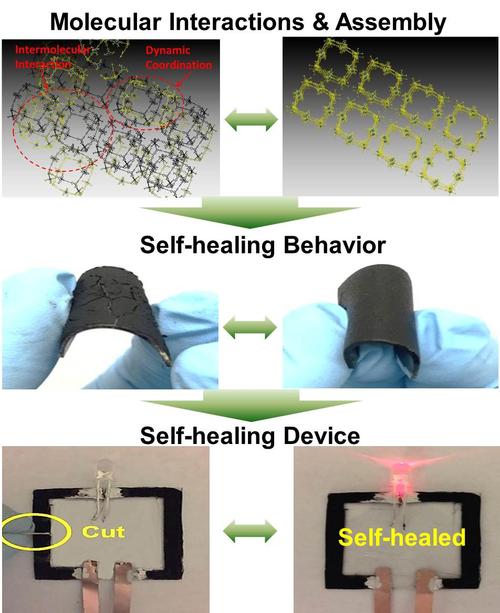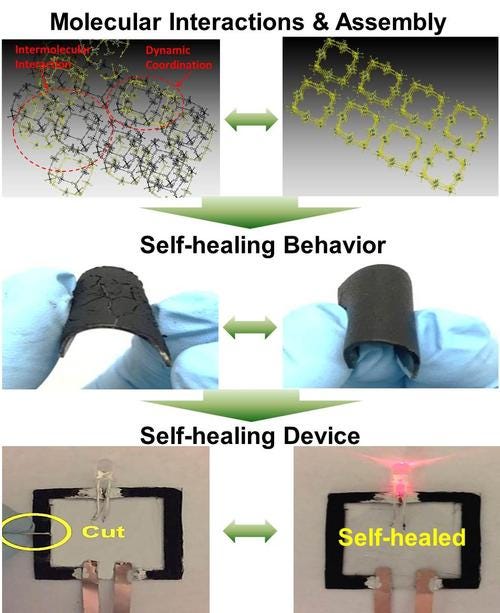December 11, 2015

A researcher at the University of Texas at Austin has developed a self-healing gel that can repair and connect electronic circuits, paving the way for new innovation in flexible electronics, biosensors, and energy-storage devices.
The gel -- which is actually a combination of two gels -- is unlike other materials previously developed for the same purpose, in that it does not need outside stimuli to activate repair, said the developer of the material, mechanical engineering assistant professor Guihua Yu in UT Austin's Cockrell School of Engineering. Yu and his colleagues published a paper describing the gel in the November issue of Nano Letters.

"Self-healing materials developed previously usually require external stimuli such as heat, light, or chemical environment change, e.g., pH change," Yu told Design News in an interview. "Our hybrid gel is composed by two gel materials which are a supramolecular gel interwoven by conductive polymer gel. Both components help construct a 3D conductive network for electron transport, resulting in high conductivity and great self-healing property at room temperature without any stimuli."
The new gel supports a trend toward building lighter, flexible electronics that can be rolled and folded, according to Yu. However, existing circuits being used to power devices are not designed to flex freely and can crack or break with normal wear and tear. The self-repairing gel would give circuits in these more flexible devices the ability to repair themselves when this happens.
However, the self-repairing gel is not meant to replace the typical metal conductors that transport electricity in these circuits. Instead, it could be used as a soft joint to join other parts of the circuit, Yu said.
READ MORE ARTICLES ON SELF-HEALING MATERIALS:
Other applications for the self-healing gel could include uses in medical research and energy storage. For instance, the gel has potential to be a better way to store electrical charge in batteries than current methods, he said.
"The gel can also be adopted in implantable biosensors to act as a flexible electrode, ensuring the durability of these devices," Yu said. "In addition, the gels could be used for the fabrication of artificial skins. Last but not the least, it can be used in many energy devices, too, e.g., it could be used as a functional binder material for advanced battery electrodes in high-density Li-ion batteries or other energy storage systems."
The National Science Foundation, the American Chemical Society, the Welch Foundation, and 3M have funded Yu's work. The research continues with an investigation into the fundamental mechanisms for the gelation and self-healing property of the gel to optimize their self-healing and conductive properties, as well as to study different synthetic approaches to simplify the processing if possible, he said. "This is critical for potential commercialization of these materials," Yu said.
Elizabeth Montalbano is a freelance writer who has written about technology and culture for more than 15 years. She has lived and worked as a professional journalist in Phoenix, San Francisco, and New York City. In her free time she enjoys surfing, traveling, music, yoga, and cooking. She currently resides in a village on the southwest coast of Portugal.
Like reading Design News? Then have our content delivered to your inbox every day by registering with DesignNews.com and signing up for Design News Daily plus our other e-newsletters. Register here!

Design engineers and professionals, the West Coast's most important design, innovation, and manufacturing event, Pacific Design & Manufacturing, is taking place in Anaheim, Feb. 9-11, 2016. A Design News event, Pacific Design & Manufacturing is your chance to meet qualified suppliers, get hands-on access to the latest technologies, be informed from a world-class conference program, and expand your network. (You might even meet a Design News editor.) Learn more about Pacific Design & Manufacturing here.
About the Author(s)
You May Also Like



